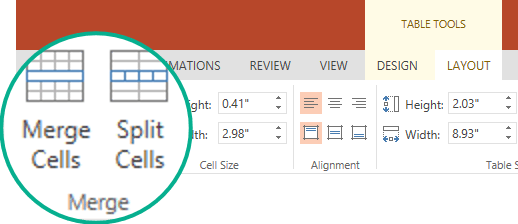

- #Excel split cells into multiple rows or columns install
- #Excel split cells into multiple rows or columns code
It is still easy with Power Query… just that we will need more steps to achieve so. However, if we are dealing with two columns like this: Indeed it is super easy IF we are dealing with one column only.
#Excel split cells into multiple rows or columns install
It’s time to download the latest version and install to your Excel (2010/2013).Į. Note: If you do not see those “Advanced options”, your Power Query could be very “old”. Make sure you have all the parameters (1-5 below) selected accordingly. Tell Power Query how you would like to split the column


Go to the Home tab of Power Query Editorĭ.We should have the following Power Query Editor opened. Verify the data range is correctly captured.Select any cell in the range of data, then press CTRL+T to insert Excel Tabl.If you are using Excel 2016 or later, Power Query is already built in and resides in Data tab, but renamed as Get and Transform. You may download Power Query for Excel in the following link: Moreover, you need to download and install Power Query for Excel as add-ins. If you are using Excel 2010/2013, Power Query has its own tab on the ribbon. Note: All the screenshots in this post are coming from Excel 365. You may download a Sample File to follow along. This could be a nightmare for most Excel users.īut you know what, with Power Query, this can be solved at ease. Second, we have more than one cells with this kind of unstructured data. First, I want the cell contents to be split into rows, and unfortunately, we don’t have Text to Rows in Excel. That’s the era before I know Power Query.Īlthough I used a trick of using Text to Columns to solve the problem before, this time the situation is different. It reminded me of an old post How unorganized data could drive you crazy which I wrote about four years ago. A cell may contain two to five items and we want to split them into individual cells, into rows. The problem here is the contents in cells are separated by a line feed ( line break). Resize(UBound(y, 2), 9) = Application.After an in-house training, a colleague came to me and asked if there is a way to do the following: ElseIf LCase(x(i + 1, 1)) Like "*clergy*" Then.If Not LCase(x(i + 1, 1)) Like "*clergy*" Then.Option Explicit Sub parsedata() Dim lr As Long Dim ws As Worksheet Dim vcol, i As.
#Excel split cells into multiple rows or columns code
Hi Cordman31, use the code mentioned below is working as per your requirement.Can I use a macro for this Ive tried doing it but it seems to not get all of the rows. ElseIf LCase(x(i + 1, 1)) Like "*ct*" Then I have a giant list rows, multiple rows need to be grouped and set to different worksheets.Do Until x(iv, 1) Like "*-*" Or IsNumeric(Left(x(iv, 1), 1)) Or LCase(x(iv, 1)) Like "Email".Or Len(x(i, 1)) = UBound(x, 1) Then Exit Do.Dim x, y(), i As Long, ii As Long, iii As Integer, iv As Long.Please let me know if you have any questions and I sincerely appreciate any feedback on this, thanks! OUTPUT: Should be listed in the same worksheet (starting in B1) and look as follows using the sample data from above: The number of rows in COLUMN A can vary where one set of data starting with 'Email' and ending with 'Clergy' may be 8 rows, another data set may be 7 rows and so on.

'Email-Parish') and the ending value is 'Clergy:' (i.e. GOAL: The output should take all of the data in COLUMN A (starting in A1 until N rows) and split it into multiple COLUMNS and ROWS, where the starting value is 'Email' (i.e. INPUT: I have data that appears like the following going down 1500+ rows all in COLUMN A:Įmail-Parish " "


 0 kommentar(er)
0 kommentar(er)
